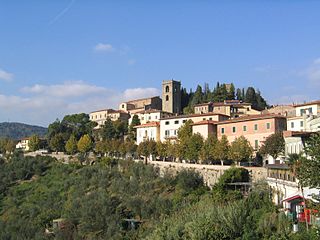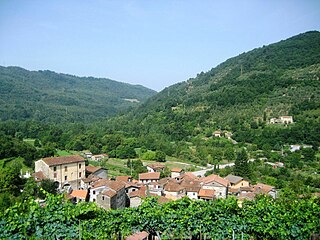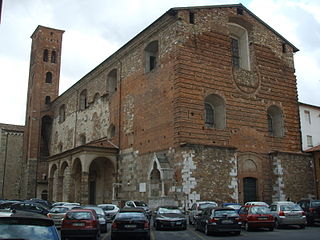
Lucca is a city and comune in Tuscany, Central Italy, on the Serchio River, in a fertile plain near the Ligurian Sea. The city has a population of about 89,000, while its province has a population of 383,957.

The province of Lucca is a province in the Tuscany region of Italy. Its capital is the city of Lucca.

Montecatini Terme is an Italian comune (municipality) of c. 20,000 inhabitants in the province of Pistoia, in the Italian region of Tuscany. It is the most important center in Valdinievole. The town is located at the eastern end of Piana di Lucca and has a strong tourism industry, as well as industrial and commercial industries related to the spa, which in turn has increased the interest in hotel accommodation in the region.

The Republic of Lucca was a medieval and early modern state that was centered on the Italian city of Lucca in Tuscany, which lasted from 1160 to 1805.

Bagni di Lucca is a comune of Tuscany, Italy, in the Province of Lucca with a population of about 6,100. The comune has 27 named frazioni (wards).

Borgo a Mozzano is a town and comune in the province of Lucca, in northern Tuscany (Italy), located on the Serchio River.

Coreglia Antelminelli is a comune (municipality) in the Province of Lucca in the Italian region Tuscany, located about 70 kilometres (43 mi) northwest of Florence and about 25 kilometres (16 mi) north of Lucca.

Villa Basilica is a comune (municipality) in the Province of Lucca in the Italian region Tuscany, located about 50 kilometres (31 mi) northwest of Florence and about 13 kilometres (8 mi) northeast of Lucca.

The Villa Marlia or Villa Reale di Marlia is a late-Renaissance palazzo or villa, and its estate's property that includes renowned gardens and adjacent villas and follies within the compound. It is located in Capannori, in the Province of Lucca, west of Florence, in the northern Tuscany region of Italy.

Codiponte is a village in the municipality of Casola in Lunigiana, Tuscany, Italy. It is located in the Province of Massa and Carrara and is about 20 minutes drive from the comune of Aulla. The population is about 200.

The Ducal Palace is a palace in Lucca, Tuscany, central Italy.

The Garfagnina or Garfagnana is an Italian breed of domestic goat from the mountainous Garfagnana area north of Lucca, in Tuscany in central Italy, from which it takes its name. It is raised in that area, in the comuni of Camporgiano, Careggine, Castelnuovo di Garfagnana, Fosciandora, Minucciano, Pieve Fosciana, Vergemoli and Villa Collemandina; in the comuni of Bagni di Lucca, Barga, Coreglia Antelminelli and Fabbriche di Vallico in the Media Valle del Serchio; and in the historic area of the Controneria, to the north-east of Bagni di Lucca. It may also be known as the Capra della Media Valle del Serchio or as the Capra della Controneria. It is probably the last remnant of the Apennine type of goat of Emilia, Liguria and Tuscany.

San Romano is a deconsecrated Roman Catholic Church located on Piazza San Romano in the center of Lucca, region of Tuscany, Italy. It stands adjacent to the Ducal Palace of Lucca.

Piazza dell'Anfiteatro is a public square in the northeast quadrant of the walled center of Lucca, region of Tuscany, Italy. The ring of buildings surrounding the square follows the elliptical shape of the former second century Roman amphitheater of Lucca. The square can be reached through four gateways located at the four vertices of the ellipse. A cross is carved into the central tile of the square with the arms pointing to the four gateways of the square.
The Aqueduct of Nottolini is an aqueduct in Neoclassical Style near the city of Lucca, region of Tuscany, Italy. The 19th-century structure brought water to Lucca from the mountains south of the city through a stone channel supported by more than 400 arches, stretching for over 3 kilometres. It is now interrupted by the east-west autostrada A11 from Florence to Pisa.
Lorenzo Nottolini was an architect and engineer of the Neoclassic style in Lucca, Italy.
The Specola Di Lucca is a Neoclassic-style former astronomical observatory built during the early 19th century near the Royal Villa at Marlia, near Lucca, region of Tuscany, Italy. The architect Lorenzo Nottolini was commissioned in 1819 to build the structure by Duchess Maria Luisa di Borbone.
The following is a timeline of the history of the city of Lucca in the Tuscany region of Italy.
The Hunting Lodge of Duke Charles II of Parma, also listed in Italian as either Casino di Caccia di Carlo Ludovico Borbone, or Villa Bellosguardo in reference to later owners, is a rural villa in the hamlet of Pieve Santo Stefano in the province of Lucca, Tuscany, Italy. The main villa was designed circa 1838 by Lorenzo Nottolini for Charles II, Duke of Parma. The piano nobile, with a Rococo roofline leads from a balcony via two curved external staircases to a garden belvedere. It is presently used for lodging and cultural functions.

Neoclassical architecture in Tuscany established itself between the second half of the eighteenth century and the first half of the nineteenth century within a historical-political framework substantially aligned with the one that affected the rest of the Italian peninsula, while nonetheless developing original features.















